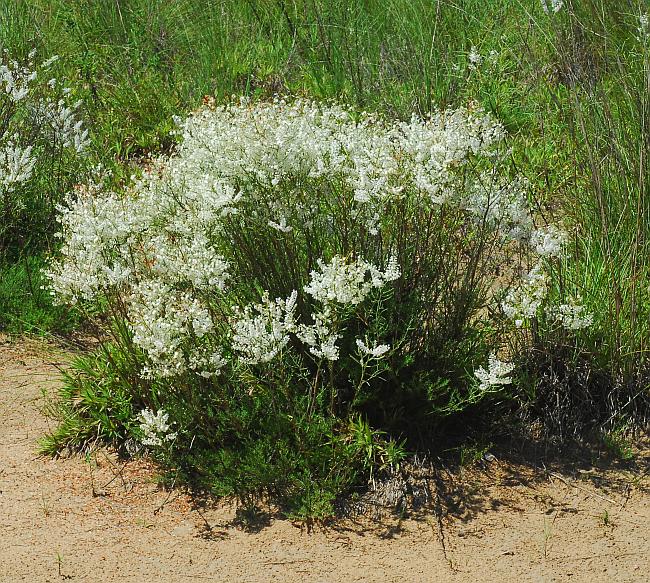Polygonum americanum (Fisch. & C.A. Mey.) T.M. Schust. & Reveal
Jointweed

Native
CC = 10
CW = 5
MOC = 3
SRank = S2
© SRTurner
Polygonum americanum (Fisch. & C.A. Mey.) T.M. Schust. & RevealJointweed | |
 |
Native CC = 10 CW = 5 MOC = 3 SRank = S2 |
© SRTurner |
|
Family - Polygonaceae Habit - Shrub with woody taproots. Stems - Spreading to erect, to 1.0 m, multiple from base, densely branched, the ultimate branches usually relatively short, herbaceous, grayish green to yellowish green, sometimes slightly glaucous, suffrutescent at the base, resembling a small cedar when not in flower. Ocrea with a lighter green to yellowish apical margin.
Leaves - Alternate, sessile, dense on the ultimate branches, sparser on the main stems, sometimes shed early. Blades 0.4-1.2 cm long, mostly 8-12 times as long as wide, linear to narrowly oblanceolate, somewhat thickened and succulent, yellowish green to green, angled to a bluntly or sharply pointed, thin and somewhat translucent tip, green, occasionally slightly glaucous, lacking longitudinal folds or grooves, the secondary venation obscure, the margins entire.
Inflorescences - Terminal spikelike racemes, these often grouped into panicles, the flowers usually solitary at the nodes and spreading in all directions along the axis. Pedicels white, glabrous, 3-4 mm long, arising from the axil of a reduced bract. Bracts scalelike, enclosing the stem, overlapping, acute to acuminate at the apex, with a whitish apical margin, glabrous, with white speckling (use a lens to see).
Flowers - Tepals usually 5, fused at the very base, with somewhat irregular margins, glabrous; the outer whorl of 2 tepals 1.2-2.0 mm long at flowering, becoming persistently reflexed as the flower opens, elliptic to ovate, white with a green midnerve, sometimes pinkish-tinged at fruiting; the inner whorl of 3 tepals 1.5-3.0 mm long and loosely ascending at flowering, becoming enlarged to 3.0-4.5 mm at fruiting, ovate to nearly circular, notched at the tip, usually white at flowering, but often becoming pinkish-tinged or pink as the fruit matures (pinkish brown with age). Stamens about 8, erect, exserted. Filaments white, glabrous, broadened in the basal half, 2 mm long. Anthers white to pinkish, 0.6 mm long. Ovary superior, white, 3-angled, glabrous, white with minute pinkish tips. Receptacle with a reddish rim surrounding a green nectary.
Fruits - Achenes, more or less enclosed, the surface smooth, reddish brown, glabrous, shiny. Flowering - July - October. Habitat - Open sandy ground in sand prairies, sand savannas, borrow pits. Origin - Native to the U.S. Lookalikes - Juniper or cedar shrubbery, when not bloooming. Other info. - This distinctive species is uncommon in Missouri, found in only a few counties which contain parts of Crowleys Ridge. Beyond Missouri the species is restricted to widely scattered locations in a few southern states. The plant is easily identified by its habitat, shrubby appearance, and branched inflorescences with numerous small white flowers. When not flowering it resembles a small cedar or juniper. Nothing else in the state's flora resembles a blooming plant. Photographs taken at the Holly Ridge Conservation Area, Stoddard County, MO., 6-14-03 (DETenaglia); also at Sand Prairie Conservation Area, Scott County, MO, 7-30-2015 (SRTurner). |